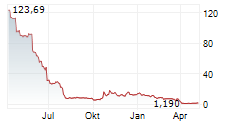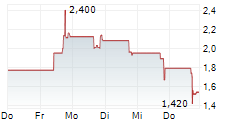Biomarkers at 6-week interim analysis show a positive impact on fibrogenesis, fibrolysis and potentially the initiation of a repair response
The Independent Data Monitoring Committee (IDMC) has recommended to continue the study as planned as there are no safety concerns seen in the data reviewed
Phase 2a study fully enrolled; Topline data on track for Q3 2025
Currently available treatments for IPF are limited to only two approved drugs that come with significant side-effects, limited patient compliance and no impact on survival
LA JOLLA, CA, July 31, 2025 (GLOBE NEWSWIRE) -- GRI Bio, Inc. (NASDAQ: GRI) ("GRI Bio" or the "Company"), a biotechnology company advancing an innovative pipeline of Natural Killer T ("NKT") cell modulators for the treatment of inflammatory, fibrotic and autoimmune diseases, today reported interim 6-week biomarker results from its ongoing Phase 2a study evaluating GRI-0621 for the treatment of Idiopathic Pulmonary Fibrosis ("IPF").
In the second interim analysis, biomarkers of fibrogenesis and fibrolysis, or the formation and degradation of collagen and extracellular matrix (ECM) turnover in fibrosis, were assessed from the first 24 subjects at 6 weeks. GRI-0621 treated patients demonstrated a favorable reduction in fibrogenesis biomarkers (PRO-C3 and PRO-C6) and a net fibrolytic profile shown as the ratio of collagen formation to collagen degradation (e.g., PRO-C3/CTX-III, PRO-C4/C4Ma3 and PRO-C6/C6M ratios). Taken together, GRI-0621 treated patients demonstrated increased basement membrane remodeling (C1M, C3M, C4Ma3, and C6M) and induction of a potential repair mechanism compared to patients in the control arm. Based on the available interim data reviewed, the IDMC has recommended the Phase 2a study evaluating GRI-0621 to continue as planned as there are no safety concerns seen to date and that more patient data is needed to confirm the anti-fibrotic effect of GRI-0621 treatment compared to the standard of care in the control arm and to assess whether the change in baseline of GRI-0621 patients compared to placebo patients is suggestive of pulmonary function improvement.
"These 6-week interim biomarker data, while early and based on a small subset of participants, continue to be encouraging. Although the study remains blinded and we do not yet have visibility into individual patient data, background anti-fibrotic use or demographic distribution, we are seeing promising directional signals with GRI-0621, including reduced fibrogenesis, increased fibrolysis and improvement in the remodeling rate, or net changes in ECM formation versus resolution. These findings remain consistent with the results seen at the 2-week interim analysis and provide further insight into the full potential of GRI-0621," commented Marc Hertz, PhD, Chief Executive Officer of GRI Bio. "Our team remains focused on the successful execution of the study and look forward to reporting topline data later this year, and hope to be able to report findings regarding pulmonary function in the coming weeks."
The Phase 2a, randomized, double-blind, multi-center, placebo-controlled, parallel-design, 2-arm study enrolled approximately 35 subjects with IPF who were randomized in a 2:1 ratio for GRI-0621 4.5mg or a placebo. GRI-0621 dose of 4.5mg will be compared with a dose of placebo following once daily oral administration for 12 weeks. Concurrently, a sub-study will examine the number and activity of NKT cells in bronchoalveolar lavage ("BAL") fluid for up to 12 eligible subjects (across various centers). The primary endpoint for the study is safety and tolerability of oral GRI-0621 as assessed by clinical labs, vital signs and adverse events after 12 weeks of treatment. Secondary endpoints are baseline changes in serum biomarkers collected at week 6 and week 12; an assessment of the pharmacokinetics (PK) of GRI-0621 at the week 12 visit of treatment (steady state); and a determination of the pharmacodynamic activity of oral GRI-0621 as measured by inhibition of iNKT cell activation in blood after 6 weeks and 12 weeks, and from BAL fluid after 12 weeks of treatment in a sub-study. Additional exploratory endpoints for the study are to assess the effect of GRI-0621 on pulmonary function at baseline and after 6 weeks and 12 weeks of treatment and flow cytometry and differential gene expression at various time points.
As previously announced, the pre-planned interim analysis for 2-week safety results from the ongoing Phase 2a biomarker study demonstrated GRI-0621 (4.5mg orally once daily) to be safe and well-tolerated in the first 12 patients evaluated per protocol and the pre-planned interim analysis for 6-week safety results from the ongoing Phase 2a biomarker study demonstrated GRI-0621 (4.5mg orally once daily) to be safe and well-tolerated in the first 24 patients evaluated per protocol. The interim analysis committee recommended the study should continue as planned following each interim analysis. The interim results show that GRI-0621's receptor selectivity is consistent with the toxicity profile observed in earlier studies evaluating oral tazarotene in over 1,700 patients treated for up to 52 weeks.
Additionally, interim biomarker results from the first 12 subjects at 2 weeks were reviewed by the IDMC and determined that the change from baseline in PRO-C3 of GRI-0621-treated patients compared to placebo patients is suggestive of anti-fibrotic effect. Based on the available interim data reviewed, the IDMC has recommended the Phase 2a study evaluating GRI-0621 to continue as planned as there are no safety concerns seen to date.
Topline results from the Phase 2a biomarker study are expected in the third quarter of 2025. Additional pulmonary function test data are expected to be reported in the coming weeks, as well as flow cytometry and differential gene expression data are expected to be reported over the coming months.
For more information about the Phase 2a study, please visit clinicaltrials.gov and reference identifier NCT06331624.
About GRI Bio, Inc.
GRI Bio is a clinical-stage biopharmaceutical company focused on fundamentally changing the way inflammatory, fibrotic and autoimmune diseases are treated. GRI Bio's therapies are designed to target the activity of Natural Killer T ("NKT") cells, which are key regulators earlier in the inflammatory cascade, to interrupt disease progression and restore the immune system to homeostasis. NKT cells are innate-like T cells that share properties of both NK and T cells and are a functional link between the innate and adaptive immune responses. Type I invariant NKT ("iNKT") cells play a critical role in propagating the injury, inflammatory response, and fibrosis observed in inflammatory and fibrotic indications. GRI Bio's lead program, GRI-0621, is an inhibitor of iNKT cell activity and is being developed as a novel oral therapeutic for the treatment of idiopathic pulmonary fibrosis, a serious disease with significant unmet need. The Company is also developing a pipeline of novel type 2 diverse NKT ("dNKT") agonists for the treatment of systemic lupus erythematosus. Additionally, with a library of over 500 proprietary compounds, GRI Bio has the ability to fuel a growing pipeline.
Forward-Looking Statements
This press release contains "forward-looking statements" within the meaning of the "safe harbor" provisions of the Private Securities Litigation Reform Act of 1995. Forward-looking statements may be identified by the use of words such as "anticipate," "believe," "contemplate," "could," "estimate," "expect," "intend," "seek," "may," "might," "plan," "potential," "predict," "project," "target," "aim," "should," "will," "would," or the negative of these words or other similar expressions. These forward-looking statements are based on the Company's current beliefs and expectations. Forward-looking statements include, but are not limited to, statements regarding: the Company's expectations with respect to development and commercialization of the Company's product candidates, the timing of initiation or completion of clinical trials and availability of resulting data, including additional data from the Phase 2 trial of GRI-0621, the potential benefits and impact of the Company's clinical trials and product candidates and any implication that the data or results observed in preclinical trials or earlier studies, topline or interim data or trials will be indicative of results of later studies or clinical trials or final data, the Company's beliefs and expectations regarding potential shareholder value and future financial performance, the Company's beliefs and estimates about its cash and available resources and its ability to fund its planned operations through any particular date, the Company's beliefs about the timing and outcome of regulatory approvals and potential regulatory approval pathways, the Company's expected milestones future milestones, and the Company's beliefs and expectations regarding the sufficiency of its existing cash and cash equivalents to fund its planned operations, its ability to raise additional funds, which may not be available to the Company on acceptable terms, or at all, and capital expenditure requirements. Actual results may differ from the forward-looking statements expressed by the Company in this press release and consequently, you should not rely on these forward-looking statements as predictions of future events. These forward-looking statements are subject to inherent uncertainties, risks and assumptions that are difficult to predict, including, without limitation: (1) the inability to maintain the listing of the Company's common stock on The Nasdaq Capital Market and to comply with applicable listing requirements; (2) changes in applicable laws or regulations; (3) the inability of the Company to raise financing in the future; (4) the success, cost and timing of the Company's product development activities; (5) the inability of the Company to obtain and maintain regulatory clearance or approval for its respective products, and any related restrictions and limitations of any cleared or approved product; (6) the inability of the Company to identify, in-license or acquire additional technology; (7) the inability of the Company to compete with other companies currently marketing or engaged in the development of products and services that the Company is currently developing; (8) the size and growth potential of the markets for the Company's products and services, and their respective ability to serve those markets, either alone or in partnership with others; (9) the failure to achieve any milestones or receive any milestone payments under any agreements; (10) inaccuracy in the Company's estimates regarding expenses, future revenue, capital requirements and needs for and the ability to obtain additional financing; (11) the Company's ability to protect and enforce its intellectual property portfolio, including any newly issued patents; and (12) other risks and uncertainties indicated from time to time in the Company's filings with the U.S. Securities and Exchange Commission (the "SEC"), including the risks and uncertainties described in the "Risk Factors" section of the Company's most recent Annual Report on Form 10-K filed with the SEC on March 14, 2025 and subsequently filed reports. In particular, the data discussed in this release is interim data and additional study and additional favorable results will be needed for development of GRI-0621 to continue; this interim data may not be indicative of later or final data for this trial. Forward-looking statements contained in this announcement are made as of this date, and the Company undertakes no duty to update such information except as required under applicable law.
Investor Contact:
JTC Team, LLC
Jenene Thomas
(908) 824-0775
GRI@jtcir.com


